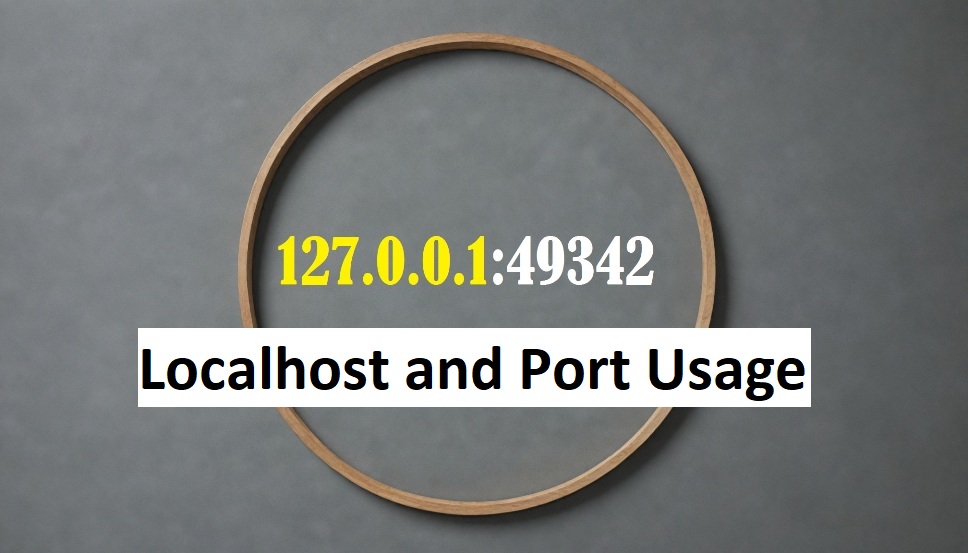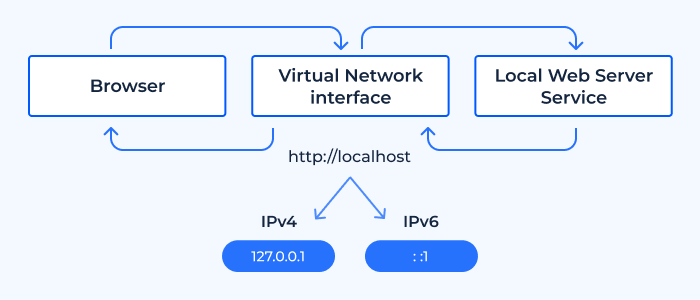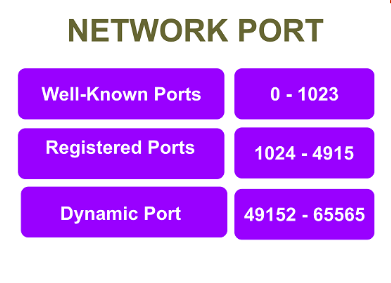127.0.0.1:49342 is a local IP address with a specific port number. It typically denotes a loopback network connection.
The IP address 127. 0. 0. 1, often referred to as “localhost,” serves a unique purpose in networking. This address allows a device to communicate with itself, primarily for testing and development purposes. The port number 49342 specifies a particular communication endpoint on the device.

When developers work on networked applications, they frequently use localhost to simulate connections without external network access. This setup ensures a controlled environment for debugging and testing software.
Understanding the significance of 127. 0. 0. 1 and port numbers like 49342 can greatly enhance a developer’s ability to troubleshoot and optimize applications. With this foundational knowledge, network communication becomes more manageable and efficient.
What is 127.0.0.1:49342?
The term “127.0.0.1:49342” might look confusing, but it’s really just a way to talk about your computer. The part “127.0.0.1” is like your computer’s home address, telling it to send information back to itself. The number “49342” is like a special door on that home where different apps or services can communicate. There are many doors (or ports) your computer can use, and this is just one of them!
Introduction To Localhost
Understanding localhost is essential for anyone interested in networking. It helps developers test applications without an internet connection. The IP address 127.0.0.1 is the standard for localhost. This blog post will guide you through the basics and importance of localhost.

What Is Localhost?
Localhost refers to your computer. It is the default name describing your local machine. Localhost uses the IP address 127.0.0.1. This address loops back to your own system. Thus, it allows testing and development without external networks.
Ports like 49342 specify different services. For instance, web servers use port 80 or 443. You can use any port number for different tasks. This ensures no conflict between services.
Importance In Networking
Localhost is crucial for developers. It enables testing web applications safely. Here are some reasons why localhost matters:
- Testing: Developers can test without risking live data.
- Security: Localhost limits exposure to the internet.
- Speed: Localhost operations are faster due to the absence of network delays.
- Isolation: Errors on localhost do not affect live systems.
Using localhost can also aid in learning. Beginners can practice coding and networking without any risk.
Understanding Ip Address 127.0.0.1
The IP address 127.0.0.1 is known as the “localhost” or “loopback” address. It allows a computer to communicate with itself. This is essential for testing and network software development.
Loopback Mechanism
The loopback mechanism uses the IP address 127.0.0.1. It lets your computer send and receive data without leaving the device. This is crucial for testing software in a controlled environment.
Here’s a simple breakdown:
| Component | Description |
|---|---|
| IP Address | 127.0.0.1 |
| Function | Loopback |
| Purpose | Local testing and development |
This loopback feature ensures that network developers can troubleshoot issues locally. It minimizes external variables affecting the test results.
Common Use Cases
There are several common use cases for the 127.0.0.1 IP address:
- Testing new web applications
- Configuring local servers
- Debugging network services
Developers often use 127.0.0.1 to test web servers. For example, a developer can run Apache or Nginx locally to ensure everything works before going live.
Another use case involves configuring firewalls. By adding rules for 127.0.0.1, you can manage what traffic stays within your system.
Debugging is easier with 127.0.0.1. You can isolate issues in your code without network interference. This helps in identifying bugs more quickly.
Understanding the importance of 127.0.0.1 can streamline your development process. It offers a safe and reliable way to test and debug.
Role Of Ports In Networking
Ports are crucial in computer networking. They help route data to the correct place. Each port has a unique number. This ensures data reaches the right application. Let’s explore the purpose and working of ports.

Purpose Of Ports
Ports serve as communication endpoints. They allow devices to interact over a network. Each port number corresponds to a specific service. For example, port 80 is used for HTTP. Port 443 is for HTTPS. This helps manage traffic efficiently.
Ports also enhance security. Only necessary ports are open. This reduces vulnerability to attacks. Firewalls can block unwanted traffic by closing ports. This keeps networks safe.
How Ports Work
Ports work with IP addresses. Together, they identify devices on a network. 127.0.0.1:49342 is an example. 127.0.0.1 is the IP address. 49342 is the port number.
Here is a simple table to illustrate this:
| IP Address | Port Number |
|---|---|
| 127.0.0.1 | 49342 |
When data is sent, it includes both IP and port. The receiving device reads the port number. It then routes the data to the correct application. This ensures efficient and accurate data delivery.
Ports can be classified into three types:
- Well-Known Ports: 0 to 1023
- Registered Ports: 1024 to 49151
- Dynamic Ports: 49152 to 65535
Well-known ports are used for common services. Registered ports are for specific applications. Dynamic ports are assigned as needed.
Understanding ports is key to managing a network. They help control data flow and enhance security. Knowing how they work can prevent many issues.
Port 49342 Explained
Port 49342 is a dynamic or private port. These ports serve various purposes. They are usually assigned temporarily. Understanding this port can help in network troubleshooting.
Dynamic And Private Ports
Dynamic ports range from 49152 to 65535. They are also called private ports. These ports are not permanently assigned. They are often used by applications for short-term needs.
Port 49342 falls within this range. It is often used by client applications. These applications request services from a server. The server, in turn, responds to the client.
Typical Applications
Many applications use dynamic ports. Here are some examples:
- Web browsers
- Online games
- File sharing apps
These applications connect to servers. They use dynamic ports to establish connections. This ensures smooth communication between client and server.
In some cases, network administrators monitor these ports. They may do this for security or troubleshooting purposes. Knowing the role of port 49342 can be helpful.
Benefits Of Using Localhost
Using localhost, such as 127.0.0.1:49342, offers many advantages. These include improved development, testing, and security for web projects. Localhost is a powerful tool for developers and IT professionals.
Development And Testing
Localhost is perfect for development and testing environments. Developers use it to create and test websites before going live. This ensures that the site functions correctly and is bug-free.
Localhost allows for quick changes and instant feedback. This speeds up the development process. It also saves resources by not using a live server.
- Instant feedback on changes
- Cost-effective testing
- No need for a live server
Security Advantages
Using localhost also has significant security advantages. Since it’s a local environment, it’s isolated from the internet. This reduces the risk of cyber-attacks and data breaches.
Developers can safely test new features without exposing them to the public. This helps in maintaining the integrity and security of the project.
- Isolated environment
- Reduced risk of attacks
- Safe testing ground
Common Issues And Troubleshooting
Connecting to 127.0.0.1:49342 can sometimes be tricky. Many users face common issues. This section will cover how to resolve these issues. We will look at connection refused errors and firewall configurations.
Connection Refused Errors
A “connection refused” error means something blocks your connection. Here are some common causes:
- The server is not running.
- The port is not open.
- Incorrect IP address or port number.
To troubleshoot, follow these steps:
- Check if the server is running.
- Ensure the port 49342 is open.
- Verify the IP address is 127.0.0.1.
Firewall Configurations
Firewalls can block connections to 127.0.0.1:49342. Adjust firewall settings to allow traffic. Here is how:
| Step | Description |
|---|---|
| 1 | Open firewall settings. |
| 2 | Add a new rule for port 49342. |
| 3 | Allow connections to 127.0.0.1. |
These steps should help fix any firewall issues. Remember to save changes.
Advanced Localhost Configurations
Using 127.0.0.1:49342 for advanced localhost configurations allows for a customized development environment. You can tweak settings to fit your specific needs. This helps in testing various scenarios without affecting the live site.
Customizing Hosts File
The hosts file maps domain names to IP addresses. Modify it to create custom URLs for your local server.
To edit the hosts file:
- Open the file with administrator privileges.
- Add an entry like
127.0.0.1 mycustomsite.local. - Save the changes.
This redirects mycustomsite.local to your local server. It helps in testing sites with custom URLs.
Running Multiple Servers
Running multiple servers on one machine can be done using different ports. The default localhost uses port 80. For another server, use port 49342.
Example:
- Server 1:
127.0.0.1:80 - Server 2:
127.0.0.1:49342
Configure your server settings to listen on these ports. This way, you can run multiple projects simultaneously.
| Server | IP Address | Port |
|---|---|---|
| Server 1 | 127.0.0.1 | 80 |
| Server 2 | 127.0.0.1 | 49342 |
This table summarizes the configuration for running multiple servers. Each server has a unique port.
Practical Examples
Understanding 127.0.0.1:49342 can greatly enhance your local development work. This IP address is essential for testing and setting up local servers. Let’s dive into some practical examples to see how you can use this IP address effectively.
Setting Up A Local Server
To set up a local server with the IP 127.0.0.1, follow these steps:
- Install a web server like Apache or Nginx.
- Configure the server to listen to 127.0.0.1:49342.
- Place your website files in the server’s root directory.
- Start the server to access your site locally.
Here’s a sample configuration for an Apache server:
Listen 49342
DocumentRoot "/path/to/your/site"
ServerName localhost
After setting this up, you can visit http://127.0.0.1:49342 in your browser to see your site.
Testing Web Applications
Using 127.0.0.1:49342 is ideal for testing web applications. Follow these steps:
- Deploy your web application to the local server.
- Access the application via 127.0.0.1:49342.
- Run your test cases and monitor performance.
Here are some key benefits of local testing:
| Benefit | Description |
|---|---|
| Speed | Local testing is faster than remote. |
| Security | Local tests are not exposed to the internet. |
| Cost | Free compared to cloud services. |
To illustrate, here’s a simple Python script using Flask:
from flask import Flask
app = Flask(__name__)
@app.route('/')
def home():
return "Hello, World!"
if __name__ == "__main__":
app.run(host='127.0.0.1', port=49342)
Run this script and visit 127.0.0.1:49342 to see your app in action.
Frequently Asked Questions
What Is 127.0.0.1:49342?
127. 0. 0. 1:49342 refers to a local IP address with a specific port. It’s often used in networking and web development for testing and debugging.
Why Use 127.0.0.1 In Development?
127. 0. 0. 1 is the loopback address for your computer. It’s used for local testing, ensuring that network requests don’t leave your machine.
How Does Port 49342 Function?
Port 49342 is a random, ephemeral port number. It’s used temporarily for network communications and testing purposes, often in development environments.
Is 127.0.0.1:49342 Safe To Use?
Yes, 127. 0. 0. 1:49342 is safe for local testing. It’s isolated from external networks, minimizing security risks during development.
Conclusion
Understanding 127. 0. 0. 1:49342 helps improve your grasp of networking concepts. These insights can troubleshoot local server issues effectively. Keep exploring and experimenting with network configurations to enhance your skills. By mastering these basics, you can resolve common network problems with ease and confidence.